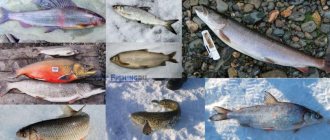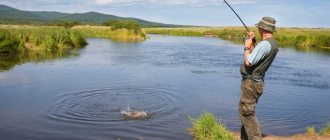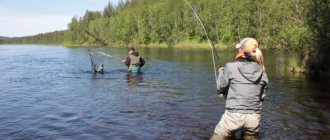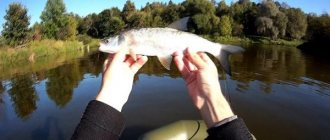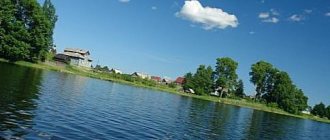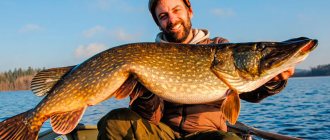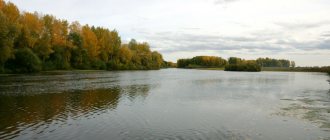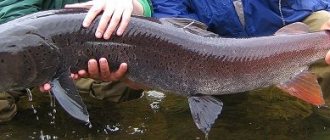Fishing in the Altai Republic and Gorno-Altaisk
- this is an interesting and long-awaited event for all fishermen, especially since in the wide Altai expanses there is always the opportunity to visit several reservoirs at once. This fascinating region, comparable in area to the British Isles, has always attracted people with its rich natural resources. And in terms of fishing, no other region can compare with the Altai Mountains. Fans of fishing call Altai a real fishing mecca and come here for new trophies and emotions several times a year, despite the fact that sometimes they have to travel thousands of kilometers to do this. Fishing in the Altai Mountains brings a rich catch in any season. This feature of local reservoirs is determined by their origin, water composition and freezing time. However, experienced anglers will tell you that the best period for your favorite activity is late summer and early autumn.
Reservoirs of the Altai Republic
Map of reservoirs of the Altai Republic The
Altai Republic is famous for its rich and healing nature, unique ecology, which harmoniously includes lakes of the Altai Republic - of different sizes and types, representing habitats for different valuable species of fish. Altai is rich in colorful and clear mountain lakes, often located at a considerable altitude above sea level. These are, for example, the Karakol lakes, one of the most attractive in Altai, located at an altitude of 1820 and 2100 meters. One of the largest reservoirs in the Altai Territory, which is of glacial origin, is Lake Bolshoye Kucherlinskoye, at an altitude of 1790 meters. It is densely surrounded from the east and west by three-kilometer Altai peaks. Its length is more than five kilometers, and its width is approximately 900 meters.
The ecology of the area and its fish resources now, according to experts, need support and restoration. Therefore, recently fishing in the Altai Republic was limited for some types of fish. In particular, in many areas, fishing for nelma, sturgeon, lenka, and sterlet native to the Altai Republic was limited. The Altai Republic is rich in valuable species of this fish, but the development of its populations and the increase in the number of fish on the territory of the republic requires the care of fisheries conservation and professional ecologists.
The largest waterways of the Altai Republic are, of course, the Katun, Biya and the Ob formed at their confluence. Both local and visiting fishing enthusiasts flock to the shores of these deep reservoirs every year.
More remote, but no less rich in catch, are the fast-moving mountain rivers Argut, Chuya, Alei and Chulyshman. In Altai there are many quiet rivers and stagnant lakes with crystal clear and transparent water, lying in karst gorges at the foot of the mountains. Such ecosystems provide excellent conditions for the reproduction of commercial fish species. The lakes, fed by glaciers, communicate with each other through narrow channels. There are thirteen thousand such water systems here. The most famous of them are Lake Teletskoye, as well as Sorochiy Log, a favorite fishing spot for Barnaul residents. In Altai reservoirs, well-known species of fish are found in large numbers: crucian carp, carp, pike perch, bream, pike, burbot, perch, tench.
However, in mountain rivers you will definitely catch specimens specific to this region: taimen, trout, grayling, lenok. The local variety of whitefish is often caught on the fishing line - peled, omul, Siberian vendace, but most often they can be caught during the winter fishing season.
By the way, during the cold season in Altai you can fish from November to March, and even harsh weather conditions do not stop fishermen going for a trophy in severe frosts. As a rule, their dedication to their work is always rewarded with a rich catch. In winter, the fish lacks food, so it is easy to feed them. In the frozen Ob, carp, crucian carp and perch are successfully caught through the holes. But on the banks of the mountain rivers Argut and Chulyshman you can try to catch grayling hiding from the severe cold in the depths. Large trout are found on the Blue Lakes, located near the village of Askat.
Fishing enthusiasts enjoy not only the fishing process itself, but also the contemplation of local beauty, the fact that they can breathe in the cleanest air, relax and break away from the bustle of big cities. The largest lake in the Altai Mountains, Teletskoye, has all of the above advantages. It is surrounded on all sides by forest, which looks very picturesque at any time of the year. The huge expanse of water, about 80 km long, attracts both amateurs and professionals who come here specifically to catch grayling, Teletskoye whitefish, and taimen. The giant reservoir, which forms a numerous and extensive network of tributaries, is home to about 14 species of fish.
Taimen can be caught well here with a spinning rod, but those who prefer fly fishing will certainly enjoy the local grayling that lives in the bottom areas of the lake. Taurus dace is excellently caught on classic fishing rods with floats. Closer to September, fishermen come to Lake Teletskoye for the pike predator.
In November there are also many fishermen who settle in the unfrozen creeks with fishing rods, waiting for their catch. For example, in the southern part the lake is often left without an ice shell. At the same time, ice fishing brings a fairly large catch. Some fishermen, having cleared the ice from the snow cover, can, as if through glass, watch the fish swimming in the reservoir. And catching them will be double luck. During the cold season, fishermen go to Lake Teletskoye for burbot, perch or pike. To catch them, balancers or silver baits in the form of fry are used.
Other interesting places for fishing are lakes Talmen, Kaldinkul, Shavlinsky lakes and Uymen. Grayling and trout are often found here.
By the way, trout in Altai can be found in other rivers and lakes with crystal clear water, for example in the Ulagan lakes. A knowledgeable fisherman will catch this whimsical commercial fish in the Karatashinsky lakes. Trout is found in Lake Darashkol, in the upper reaches of Pyzhi, Uykaratash and in lakes near the village. Productive.
Specific to the reservoirs of the Mountainous Republic, taimen or “king fish”, as the locals call this fish, is not often caught on bait. This fish is distinguished by its caution and large size: in the Katun and Biya rivers there are 2-3 kilogram specimens weighing up to 40-50 kilograms. Also, taimen comes across to those who like fishing in fast-moving mountain streams with a rocky bottom.
Mountain Altai gives fishing lovers an unforgettable experience and the opportunity to try their luck in the most diverse corners of this rich region. Wherever you go - to lakes with clear water or to roaring mountain rivers - everywhere you can count on a rich catch. At the same time, experienced fishermen recommend selecting gear based on the characteristics of the chosen location. If you are traveling to mountain rivers, be sure to take spinning rods with a short handle with you. If you decide to fish on the shores of a stagnant lake, then you need to take long fishing rods with the ability to cast over a long distance. “Boat” fishermen can use long fishing rods or short fishing rods.
Fishing in Altai will give you vivid emotions and allow you to fully enjoy the silence of lakes surrounded by mountain ranges, clean air that has absorbed the aroma of steppes, mountains and water, the loud roar of mountain rivers running through the gorges, and, of course, an excellent bite.
Places for successful fishing
When going fishing , it is worth considering that different types of fish are found in different bodies of water:
- Karatash and Ulagan lakes are rich in trout and peled.
- In the Shavlinsky lakes, as well as on the Chuya, Boshkaus and Chulyshman rivers, grayling can be successfully caught.
- At the Pravdinsky Reservoir you can catch bream, perch and pike.
- There is a lot of fish in the Beshentsevo Reservoir: roach, pike, perch, bream and others. However, you will have to pay for the pleasure, since fishing in this reservoir is paid.
- There are many crucian carp in Lake Eraska. The best bite is observed at 42 km, if you travel along the Znake Gorsk branch.
- Excellent fishing on the Sorochy Log reservoir. Numerous species of fish are found here. Among them, the most common are: carp, crucian carp, carp, pike perch, perch, tench, pike, bream and roach.
There is a widespread legend among the local population that it was in the Altai region, on its many lakes, that life began. Although this is just a belief, these places are truly unique. They have extraordinary beauty and are famous for their huge number of different bodies of water .
For example, in Kolyvan Lake, which is one of the largest in the region, ancient algae are found. They were here before the dinosaurs appeared.
Almost always fishing in the Altai Territory ends with a successful catch. Most of the reservoirs in this region are rich in valuable fish species.
Lake Utkul, translated from the language of local Altai tribes, means “Meat Lake”. There are so many fish here that it is almost impossible to remain without a catch. The lake is home to carp, mirror carp, perch and bream.
When going fishing, it is important to remember that not all bodies of water can do this for free.
Fishing places
The most popular fishing spots:
- Katun River. Fishing on the Katun is especially good in early autumn, when the water becomes clear. The most successful area for fishing is considered to be the “Upper” Katun region, which starts from the slopes of Mount Belukha and to the mouth of the Koksa River. Katun is home to grayling and a unique type of fish - taimen.
- Biya River. The second largest and only river flowing from Lake Teletskoye. Biya is famous for the presence of the so-called “taimen pits”. Here, as in Katun, you can catch grayling or taimen.
- Chulyshman River. The valley of the Chulyshman River is now the wildest areas of Altai. The river originates in the high-mountain lake Dzhulukul and flows into Lake Teletskoye, being its largest tributary. The river is home to grayling and taimen.
- Sumulta River. It is famous for its large abundance of grayling.
- Lake Teletskoye. The largest reservoir in the Altai Mountains. Fishing on Lake Teletskoye is extremely varied. The lake is home to quite rare species of fish: taimen, uskuch, Telets whitefish, burbot, grayling, etc. There are more than 15 species of fish in total. Fishing here is possible both from the shore and from a boat. Most often, fishermen note a good bite at the mouths of numerous rivers flowing into the lake. The most popular place is Big Chile.
- Lake Talmennoe. A hard-to-reach lake in the Altai mountains. Located in the Ust-Koksinsky district, in the upper reaches of the Katun River.
- The lake is rich in grayling and whitefish. You can get to the lake by helicopter, on foot or on horseback (the journey takes about 2 days).
- Lake Kucherlinskoye. An amazingly beautiful lake with turquoise water. Located in the Ust-Koksinsky district of the Altai Republic. The lake is difficult to access; you can get there along a mountain path on horseback, on foot or by helicopter. There is a base of the same name on the shore of the lake. There are grayling in the lake.
- Lakes of the Ulagansky district. The Ulagansky district is the land of a thousand lakes; there are so many of them that it is impossible to count them. Many are still without names.
- At 21 km of the Aktash - Ulagan highway, 2 km from the road there is Trout Lake, rich in rainbow trout and whitefish, not far from the village of Balyktuyul there is a chain of lakes "Koldyn Kol" where mountain pike and osman are found, and along the route itself there are a large number of lakes, offering fishing for pike, peled, and osman.
Paid fishing
In many places along the reservoirs of the Altai Territory, recreation centers are being built specifically for fishermen. Wooden houses are erected on the shore of the reservoir or near it, in which the fisherman and his family and friends can spend the night in comfortable conditions. And in the morning, full of strength, go fishing. According to Altai phishing, the most popular bases are near Katun; the list includes Lake Teletskoye; fishing there can also be comfortable.
In addition to accommodation at the bases, many organize fishing trips for one or several days.
Common fish breeds in the Altai Mountains
Fishing in the Altai Republic
The Altai Republic is an excellent habitat for such fish species as taimen and grayling. This is what fishing fans come for.
Siberian taimen, as a rule, live in Siberian rivers and are larger in weight than salmon. In wrestling, it is not very energetic, and catching it with a spinning rod is of great sporting interest. Taimen lives in numerous rivers of the Altai Mountains and in several lakes. This is a very valuable and popular breed that prefers perfectly clean water and the Sami far corners that are untouched by civilization: clean, deep rivers with pools and pits. From this point of view, the Katun River is the habitat of this type of fish.
Taimen is a predatory fish and appropriate tackle is needed here. Most often, a spinner is used, and even an individual up to 50 kg can bite on a thin spinner. It all depends on the experience of the fisherman, the speed of the retrieve, the water flow and the size of the spoon. Experienced time fishermen make artificial bait, popularly nicknamed “mouse” because of its appearance. You can use it to catch particularly outstanding specimens. Taimen are also caught by fly fishing, and in some places they work best with live bait.
Grayling fish has always been of particular interest to fishermen. This fish is not so easy to catch, which brings a lot of excitement to a more ordinary fishing trip in the Altai Mountains. Grayling meat is very similar to the meat of young trout and has a low fat content and excellent taste. Therefore, this fish is caught not only for sport. Grayling is distinguished by its large dorsal fin, which when folded reaches the tongue-shaped adipose fin. With a relatively small weight of 500 grams, grayling is one of the most beautiful fish in Russia, thanks to its variegated color. It lives in cold, fast-flowing mountain rivers of Siberia.
In the spring, around April - May, graylings leave their wintering grounds, deep holes in the lower reaches of rivers and rise closer to the surface in order to go to spawn in tributaries with the onset of the flood. Therefore, in June - July it is especially good to catch it in the tributaries of the Katun River.
What kind of fish is found in Katun
Rocky glacier-fed rivers have insufficient primary productivity and food supply. Hard soil, cold water and fast currents determine constantly low levels of benthos, plankton and aquatic plants, which play a key role in the normal development of young animals. Such conditions are not suitable for most representatives of the ichthyofauna from the carp and salmon families, which determine the species diversity of Siberian reservoirs.
Fish in the Katun from the upper reaches to the end of the middle section is represented by a dozen taxa. These include:
- lenok (grows up to 60-70 cm and weighs up to 5-6 kg);
- taimen (150-200 cm/60-80 kg);
- grayling (40-45 cm/1.5-1.8 kg);
- dace (30-40 cm/0.5-0.8 kg);
- burbot (60-80 cm / 15-20 kg);
- Siberian char (35-50 cm / 1.3-1.5 kg);
- river minnow (10-15 cm / 80-150 g);
- perch (40-50 cm / 1.5-2 kg);
- Siberian bullfly (10-12 cm / 20-30 g);
- variegated sculpin (8-12 cm / 20-25 g).
Fishing on the Katun River in high altitude conditions means hunting for grayling, which in quantitative terms predominates over other species. Also ubiquitous are dace, sculpin gobies (uninteresting due to their small size) and burbot, which is a nocturnal predator, requires special gear, and constantly stays near the bottom under the cover of stones. The remaining fish are regularly caught as bycatch, but have uneven and small populations. This is especially true for perch and the river “monster” - taimen.
The latter is a desirable trophy for any fisherman. But here we must take into account that 1996-1998. The species is listed in the Red Books of the Altai Republic and Altai Territory.
In the lower reaches of the Katun (from Chemal and further to the lower reaches) the composition of fish expands significantly. Bream, pike, carp, gold and silver crucian carp, ide, ruffe, roach, pike perch, pike perch, and gudgeon appear. The most densely populated area is the mouth area from Maima to the Ob, which gradually acquires a flat character and is the historical habitat of sturgeon, nelma, and sterlet. The most common taxon is the Siberian dace.
Fishing on Lake Teletskoye
Lake Teletskoye is the blue pearl of Altai. The lake is one of the 15 deepest lakes in the world. About 70 mountain rivers and streams flow into Lake Teletskoye, which fill the lake with crystal clear and icy water. The area of the lake is 223 sq. km, average width - 3.2 km, length - about 80 km, maximum depth - 325 m. Such a volume of water is very difficult to warm up, so the average water temperature in the lake does not exceed +4 degrees; in the summer, the upper layers of water can warm up to +10 degrees, and the coastal strip up to +20 degrees. All these conditions affected the formation of the ichthyofauna of the lake. Fourteen species of fish live in Lake Teletskoye, two of which are endemic, i.e. are not found in other bodies of water in the world, these are the Telets whitefish and the Pravdina whitefish, but the lake is not famous for this, but for its other inhabitant - taimen, or, as it is also called “mountain” taimen. This fish deserves a separate story. This circumstance makes fishing on Lake Teletskoye attractive for trophy collectors and lovers of exotic fishing.
Both Lake Teletskoye itself and its main inhabitant, the taimen, are surrounded by various legends and myths. The lake attracts lovers of ancient legends and legends, just look at the legends about Shambhala and Belovodye. the entrance to which is supposedly located on Lake Teletskoye. For lovers of exotic and trophy fishing, a kind of Shambhala will be the legend of the Tsar Fish, a huge taimen that lives in the mysterious waters of Lake Teletskoye. Any local fisherman will tell you a lot of stories about the mysterious fish, most of which happened either to him or to his friends.
Taimen (Siberian taimen) is the largest fish in Lake Teletskoye and the most valuable, belongs to the salmon family. Some specimens reach up to 1.5 meters in length and weigh up to 50-60 kilograms, sometimes up to 70-80 kg. The largest officially registered specimen was caught in 1944 in the river. Yenisei, near Krasnoyarsk: at the age of 55, its length was about 1.5 m and its weight was 56 kg. The body of the taimen is “low”, long, somewhat compressed from the sides, the head is flat. The mouth is large, the teeth on the jaws and palate form a continuous strip. There are round dark spots on the sides and top of the head, and dark crescent spots on the sides of the body. The color of the taimen matches this fish. Greenish-brown body with pink, and during the spawning period bright red, fins. Taimen is distributed throughout the lake, but in the Chulyshman delta, in the Kamga and Kyga bays it is much more numerous. Spawning in May-early June. Taimen spawn mainly in rivers and streams flowing into the lake. The main part of Teletskoe taimen spawns in the Chulyshman rivers. Kygu, Kamgu and Koldor. After spawning, taimen fall into river mouths and the lake itself. In the short period after spawning, at the end of June, active taimen biting is observed. This is due to the so-called zhor after spawning. This period, as well as September and October, are considered the most favorable for fishing for taimen.
It is worth considering that in 1996, in order to preserve the taimen population, it was included in the Red Book of the Republic. And in 1998 - in the Red Book of the Altai Territory. Fishing for this fish has been prohibited for amateurs in recent years. Therefore, in order to avoid various excesses, it is recommended to catch taimen according to the catch-and-release principle.
Teletsky grayling (West Siberian grayling) is a representative of the grayling family, genus Salmonidae. This is a fast fish that lives in cold and clear waters saturated with oxygen. Very sensitive to water quality. The hallmark of the grayling is its unusually beautiful dorsal fin, reminiscent of a sail, which can fold and straighten, and the round multi-colored spots on the fin make it also similar to the tail of a peacock. The body of the grayling is oblong, greenish or bluish-silver, with black spots on the back, silver, with a purple tint on the sides and belly, the upper fin is large, colorfully bright, pectoral and abdominal red or yellow, anal and caudal violet, adipose fin, the head is small, the mouth is upper. Grayling is distributed throughout Lake Teletskoye. the bulk of which adheres to the mouths of rivers flowing into the lake.
Grayling is not picky about its diet. Its diet can consist of various bottom organisms: gammarus crustaceans, mollusks, larvae and other forms of insects developing in water (mayflies, stoneflies, caddisflies); as well as various terrestrial insects that accidentally fell into the water: grasshoppers, cicadas, gadflies, midges, ants. Grayling will not refuse to feast on fish eggs. Large individuals can eat juveniles of other fish. There may be cases of large grayling attacking small mammals (voles, shrews, etc.). Accordingly, based on the gastronomic preferences of grayling, its fishing is organized. Bait can be either natural baits (mayflies, stoneflies, grasshoppers, flies, gadflies, etc.) or artificial ones (various decoys, artificial flies, spinners, etc.). Often, trophy specimens can peck on artificial bait - “mouse”.
Fishing for grayling is interesting throughout the year, as it is a fairly active fish. The average body length is 25-30 cm, but larger individuals up to 45-50 centimeters and weighing up to 2-3 kilograms can also be found. Grayling spawns in May and June. To spawn, it rushes into all the rivers flowing into the lake, and can also descend into the Biya River. After spawning, grayling falls back into the lake and fattens there throughout the entire time. Grayling has high taste qualities.
Uskuch (lenok) - belongs to the salmon family, genus - lenok.
It is similar to taimen, but is significantly superior in taste. Large fish up to 70 cm in length and 5-6 kg in weight. Usually there are specimens weighing 3-4 kg. The body is volcanic, the snout is blunt, the mouth is small. The scales are small, the body color is dark brown or blackish with a golden tint. The sides, dorsal and caudal fins are covered with small round dark spots. During the spawning period there are large copper-red spots on the sides. It surpasses grayling and taimen in taste. Lenok begins to spawn after the ice melts on Lake Teletskoye at the end of April and May. Sexually mature ones rise to the upper reaches of rivers and streams flowing into the lake. Especially many enter the rivers Samysh, Koldor, Kamga, Kokshi and Kyga. After spawning, the lenok again slides into the lake and leads an active lifestyle all year round. In the lake, lenok stays in the coastal zone, rich in organic matter, in bays and river mouths. The lenka population in Lake Teletskoye is not numerous. Fishing in Altai
Teletsky whitefish (Taliy herring) belongs to the salmon family. It is endemic, i.e. found only in Lake Teletskoye. Locals call it herring, but, unlike herrings, the Telets whitefish has an adipose fin, which is characteristic of the salmon family. This is the most numerous fish in the lake. The weight of a mature Telets whitefish reaches three kilograms. Body length up to 40-50 cm or more. The body is covered with silvery scales and has an external resemblance to a herring. In the summer, when the top layer of water warms up to 14-17 degrees, whitefish swim across the entire surface of the lake, collecting insects that have fallen on the water. Teletska whitefish spawns in October and November. Before spawning, whitefish form large aggregations. Whitefish are especially abundant in Kamginsky Bay and other places where it is much calmer during autumn storms.
Whitefish Pravdina (Teletsk sprat), or sizhok, is one of the smallest representatives of salmon living in Russia. Poorly studied. It is endemic and found only in Lake Teletskoye and the Biya River. Whitefish were first discovered in 1940 and described in 1949 by G.D. Dulcate. It is extremely rare, but in August the Pravdina whitefish gathers in masses in the upper part of the Biya River, where it lingers for a short time and disappears again. Apparently, such aggregation occurs before spawning, although the exact time has not been established. It is also not established where it comes from here, whether it rises from the lower reaches or falls from the lake. This deep-sea fish possibly lives in the depths of the lake, rising to the surface in the second half of summer, where, like the Telets whitefish, it feeds on almost the entire surface of the lake, mainly in its latitudinal part. The whitefish Pravdina feeds on zooplakton. The length of the body, covered with silvery scales with a beautiful bluish tint along the back, is up to 15-17 centimeters. During the period of aggregation and spawning, protection from poachers and a complete ban on fishing during that period are necessary. Included in the Red Book of the Altai Republic.
Burbot is the only freshwater representative of cod fish. Burbot prefers cold and clean water. It feeds on small invertebrates and fish. In Lake Teletskoye the burbot population is quite numerous. This is a large, deep-sea, bottom-dwelling fish. It can descend to a depth of 100 meters or more. The size of burbot varies from 0.3 to 1.2 m. Weight can reach 10 kg. The color of burbot is yellowish-gray speckled, but depending on the environment, the color of the water and the soil, it can be dark gray speckled. Burbot spawns in January-March. It is caught well with lines and small spoons. An excellent bait for catching burbot is considered to be a ruff, or sliced fresh fish. Contrary to the popular belief that burbot fishing in summer is ineffective, on Lake Teletskoye burbot fishing is available throughout the year, this is due, first of all, to the fact that the water in the lake does not rise above 10 degrees, which has a beneficial effect on the nutrition of the fish . Burbot is distributed throughout the lake, especially numerous in the southern part of the lake. Ukha made from fresh burbot is considered one of the most delicious, if you do not take into account the broth from sturgeon fish.
The Taurus dace is a member of the carp family. Locals mistakenly call it chebak. An adult dace reaches a body length of up to 23 centimeters, weighing up to 200 grams or more. The body is covered with silvery scales of a darkish color. The dace has a semi-lower mouth and feeds near the bottom on the larvae of the mosquito mosquito (bloodworm) and other insects, as well as diatoms. During the period of mass emergence of mosquitoes, mayflies, or in cases when insects are washed away from coastal bushes by rain and wind and blown into the water, the dace feeds on them, rising to the upper layers of the water. Dace is a schooling fish and does not make large movements. As a rule, in the morning dace go out to the nearest rift, and in the evening they descend into holes or into deeper places under the shore. Sometimes they accumulate on the spawning grounds of other fish and eat the eggs they lay. Dace has no commercial significance. But catching it with a fishing rod is of some sporting interest. Despite the abundance of dace, catching it is not so easy. Dace is a fast and agile fish. The dace bite is quite sharp, and you need to hook it sharply, and not sweepingly. Fishing for dace is quite a gambling activity. The dace in Lake Teletskoye is found mainly in the southern part of the lake and only for a short time passes to the source of the Biya River. Spawning in May, June. The main habitat is Kyga Bay. The dace enters the Chulyshman River for the winter. where, clinging to the ground, it spends the winter without feeding.
Pike is a member of the pike family. The body of the pike is torpedo-shaped, the head is large, the mouth is wide, which sharply distinguishes it from other species of fish. The maximum length of pike can reach 1.5 m and weight up to 35 kg. but, as a rule, the weight reaches eleven kilograms and the length is about 1 m. The color of pike is changeable and depends on the environment. Depending on the nature and degree of development of the vegetation, it can be gray-greenish, gray-yellowish, gray-brown, the back is darker, the sides have large brown or olive spots that form transverse stripes. Unpaired fins are yellowish-gray, brown with dark spots; paired ones - orange. Pike spawning in Lake Teletskoye occurs very quickly in the second half of May. To spawn, pike go to shallow shallows flooded by spring floods, and here mass spawning takes place in the grass for 4-6 days. Pike are found throughout the lake, but mostly in the Kamginsky and Kyginsky bays, in the delta of the Chulyshman River and in the westernmost part of the lake, where there is shallow water and a lot of algae. On Lake Teletskoye in summer and winter, pike fishing is interesting mainly with spinning rods using artificial and natural baits, and in winter with girders and various lures.
Perch is a member of the perch family. An ordinary perch is dark green on top, the sides are greenish-yellow, the belly is yellowish, 5 - 9 dark stripes stretch across the body, instead of which there are sometimes dark irregular spots; the first dorsal fin is gray with a black spot, the second is greenish-yellow, the pectoral fins are red-yellow, the ventral and anal fins are red, the caudal fin, especially at the bottom, is reddish. There are a lot of perch in the shallow waters of Lake Teletskoye. Perch fishing is especially good in Kamginsky Bay and in the delta of the Chulyshman River. Body length up to 30-35 centimeters, weight up to 800 grams. Spawning at the end of May, beginning of June. Perch can be caught using earthworms and live bait, and in winter using small winter lures.
Bream is a genus of bream, the carp family. The bream is distinguished by its laterally compressed tall body (height is about 1/3 of its length), and its long anal fin (its origin lies in front of the dorsal fin). There are five pharyngeal teeth on each side. The head is small, the mouth is small. The lips of bream can stretch like an accordion to make it easier for the fish to extract food from the mud.
An adult bream has a gray or brown back, silver-gray or brownish sides, a dirty whitish belly, and all gray fins. Length 40-70 cm, weight 5-6 kg. Bream appeared in Lake Teletskoye in 1964. Came into the lake from the Ob River and the Ob Reservoir, where it was once acclimatized. The bream population in the lake is not yet large. However, it is safe to say that acclimatization in the cold-water lake was successful. Currently, the greatest concentration of bream is in the delta of the Chulyshman River. Among the small non-commercial fish that live in Lake Teletskoye are: minnow (carp family), Siberian char (loach family), spotted sculpin, Siberian sculpin, local residents call it broadhead.
Fishing on the Katun River - when you can fish
Mountain Altai belongs to the Ob-Irtysh fishery region. Special rules for amateur and sport fishing determine the permitted periods, fishing gear, and the minimum permissible size of individuals that cannot be left in the catch. If we group together all the periods during which fishing is prohibited due to spawning in different sections of the current, it turns out that fishing on the Katun River is generally prohibited from April 25 to June 25. The poorly warmed upper reaches have their own restrictions, which last from May 10 to June 20. At the same time, fishermen still have the constant opportunity to do what they love from the shore, using one float or bottom fishing rod with 1-2 hooks (double hooks, treble hooks).
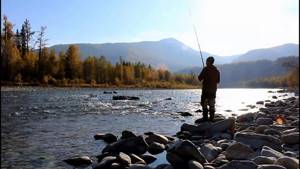
The fish caught must meet the following size minimums:
- grayling – from 180 mm;
- bream, ide – from 250 mm;
- carp, pike – from 300 mm.
- pike perch – from 330 mm;
- burbot – from 410 mm.
The maximum weight of the catch per day should not exceed 10 kg (with the exception of one individual weighing over 10 kg). Also, the daily norm limits the catch of taimen to 2 specimens.
If the spawning ban period is not in effect, it is allowed to use fly fishing rods, spinning rods and fishing rods of all modifications, including with feeders, spoons, wobblers, flies, equipment such as “boat”, “water kite”, “Tyrolean stick”. But the total number of hooks (double hooks, treble hooks) on all gear should not exceed 10 pieces.
see also
|
|
|

